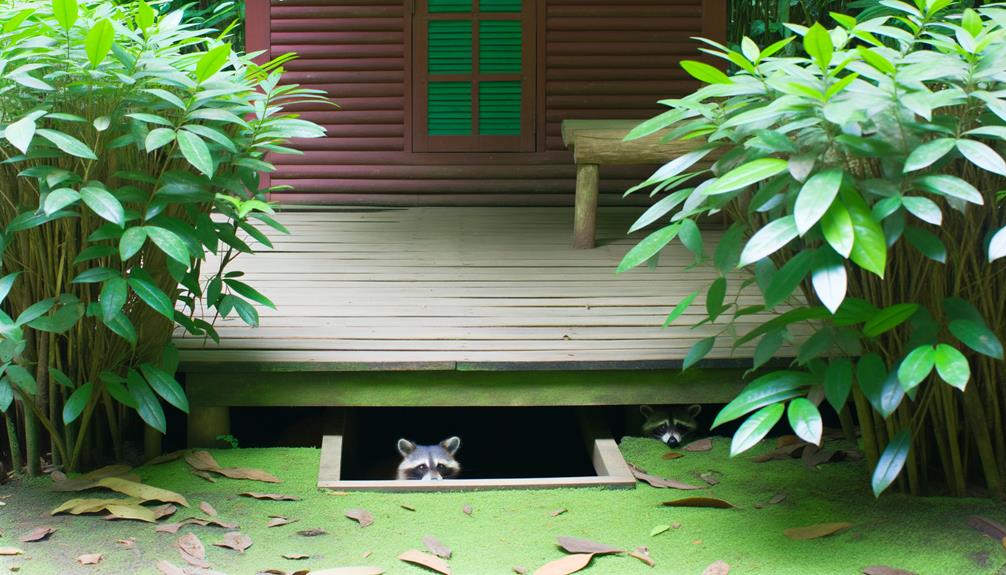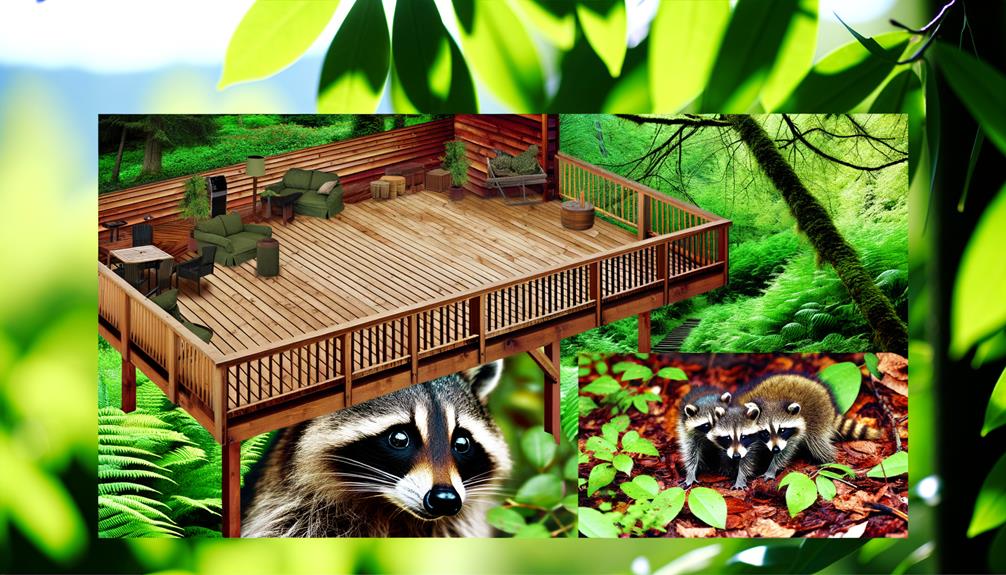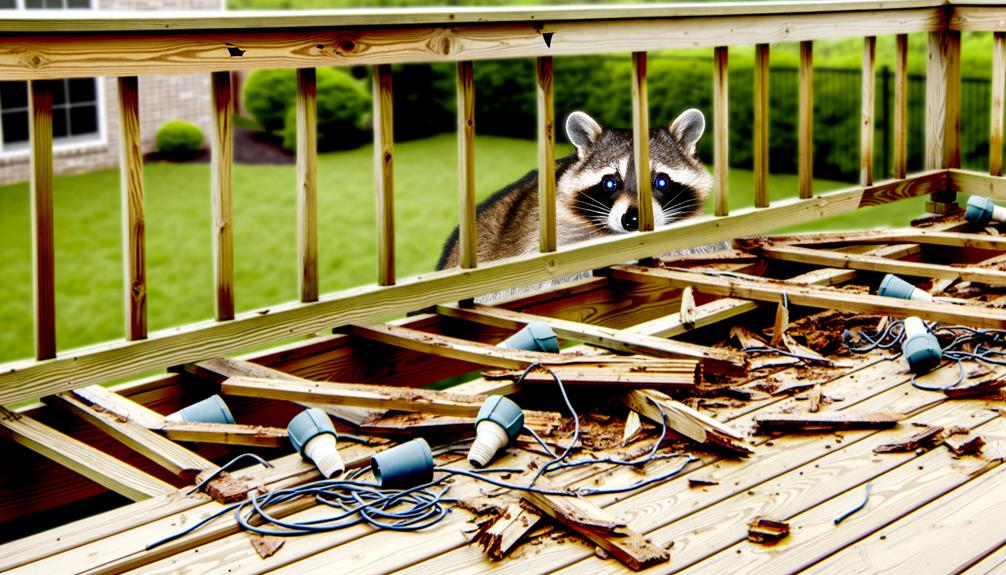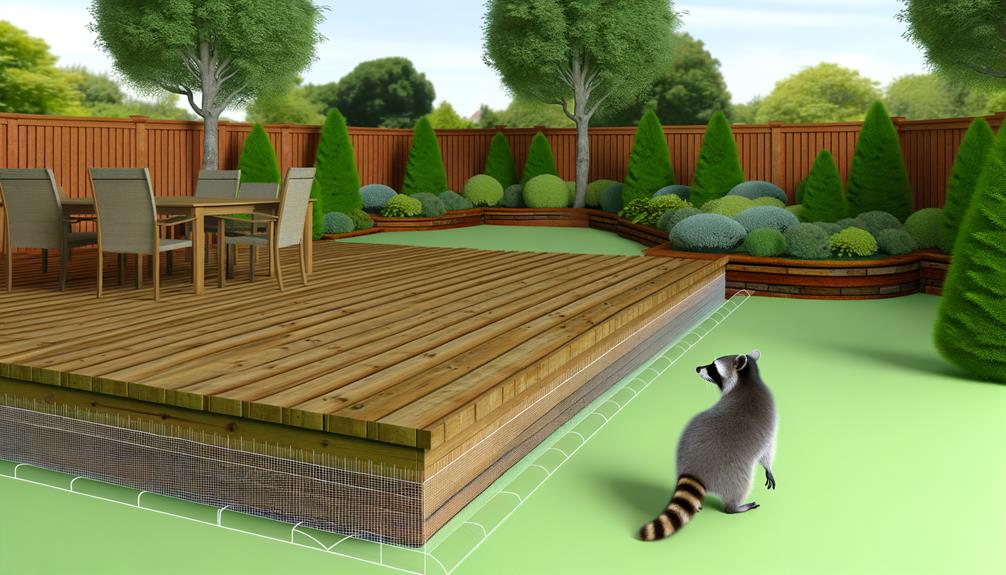Why Do Raccoons Live Under Decks?
Raccoons commonly inhabit areas under decks, which provide shelter and mimic natural dens. These locations offer safety from predators and access to urban food sources.
Signs of raccoon activity include nocturnal noises and distinctive five-toed paw prints. Their presence poses risks, such as structural damage, health hazards from diseases like rabies, and unsanitary conditions.
Humane removal methods involve live trapping and exclusion strategies. To prevent future intrusions, install physical barriers, secure food sources, and maintain a clean yard.
Consulting wildlife control professionals guarantees effective raccoon management and legal compliance. Discover more insights on handling and preventing raccoon intrusions.

Key Takeaways
- Raccoons prefer decks as they mimic natural den sites and offer shelter.
- Decks provide safety from predators and proximity to food sources.
- Nocturnal activity and distinctive paw prints indicate raccoon presence under decks.
- Raccoons pose health risks and can cause significant structural damage to decks.
- Installing barriers and modifying the habitat can prevent raccoon intrusions under decks.
Why Raccoons Choose Decks

Raccoons often choose to live under decks due to the availability of shelter, food sources, and relative safety from predators. Decks provide a structurally sound environment that mimics natural den sites such as hollow trees. The concealed space offers protection from environmental elements and a safe haven for raising their young.
Additionally, urban and suburban areas where decks are prevalent often have abundant food resources, including garbage, pet food, and bird feeders. The proximity to human habitation inadvertently reduces the threat from natural predators, creating an ideal habitat. This combination of factors makes decks a strategically advantageous choice for raccoons seeking to maximize their survival and reproductive success in both urban and suburban landscapes.
Signs of Raccoon Activity
Identifying raccoon activity under decks can be achieved by observing specific indicators such as nocturnal noise patterns and distinctive paw prints. These creatures are primarily active during the night, often resulting in audible disturbances.
Additionally, raccoon paw prints, characterized by their unique five-toed structure, can frequently be found in the vicinity of the deck area.
Nocturnal Noise Patterns
The most distinctive indicators of raccoon activity under decks at night include a series of rustling, thumping, and occasional chattering sounds. These nocturnal noises are primarily due to raccoons' foraging behavior, social interactions, and nest-making activities. Detailed observation can help differentiate raccoon sounds from other potential nocturnal animals.
| Noise Type | Description | Likely Cause |
|---|---|---|
| Rustling | Continuous, light movement sounds | Foraging through debris |
| Thumping | Intermittent, heavy impacts | Jumping or climbing |
| Chattering | Sporadic vocalizations | Communication or distress |
These auditory signals are essential for identifying the presence of raccoons, as they are typically more active during the night. Monitoring these patterns can assist in making informed decisions regarding wildlife management under residential decks.
Paw Prints Evidence
Beyond auditory cues, physical evidence such as distinctive paw prints can provide concrete confirmation of raccoon activity under residential decks. Raccoon paw prints are easily identifiable due to their unique characteristics: five elongated toes and visible claw marks.
To accurately identify raccoon presence, consider the following:
- Size and Shape: Raccoon prints are roughly 2-3 inches in length with a distinctive hand-like appearance.
- Toe Arrangement: The toes are spaced apart, creating a spread-out look that distinguishes them from other animals.
- Claw Marks: Sharp, small impressions often accompany the toe prints, indicating claw presence.
- Trail Patterns: Raccoons typically leave a wandering trail, reflecting their foraging behavior.
These indicators collectively offer a reliable method for detecting raccoons under decks.
Potential Risks and Damages

Raccoons living under decks can pose significant health risks and structural damage due to their behavior and potential for transmitting diseases. These animals are known carriers of rabies, leptospirosis, and raccoon roundworm, which can all affect humans and pets.
Structurally, raccoons may damage insulation, wiring, and woodwork while seeking shelter or creating nests. Their burrowing can undermine the stability of decks and other structures, leading to costly repairs. Additionally, raccoon feces and urine can cause unsanitary conditions and attract other pests.
The presence of raccoons often results in loud noises and unpleasant odors, further reducing the quality of living conditions. Consequently, addressing raccoon habitation under decks promptly is vital to preventing these potential issues.
Humane Removal Methods
Addressing the issue of raccoons living under decks requires implementing humane removal methods to guarantee the well-being of both the animals and the property owners.
Key considerations include live trapping techniques, which involve the safe capture and relocation of raccoons, and exclusion methods that prevent reentry without causing harm.
Additionally, seeking professional assistance can provide expert evaluation and application of these humane strategies.
Live Trapping Techniques
Implementing humane live trapping techniques is crucial for the ethical and effective removal of raccoons living under decks. The following steps guarantee a safe and humane approach:
- Choice of Trap: Utilize a live-capture cage trap, typically 12x12x32 inches, which provides sufficient space for the raccoon without causing harm.
- Bait Selection: Use appealing, non-toxic bait such as marshmallows or canned fish to lure the raccoon into the trap.
- Placement: Position the trap near the entrance of the den under the deck, ensuring it is stable and secure.
- Monitoring: Regularly check the trap to minimize stress on the captured animal, and promptly relocate the raccoon to a suitable habitat.
These methods guarantee humane treatment while addressing the issue efficiently.
Exclusion Methods Explained
Effective exclusion methods are essential in guaranteeing raccoons are humanely deterred from returning to areas under decks. These methods focus on denying access while minimizing harm. Key strategies include installing physical barriers, such as hardware cloth or lattice, and utilizing one-way exclusion doors that allow raccoons to exit but not re-enter. Additionally, addressing attractants like food sources and garbage is critical.
| Method | Description | Pros |
|---|---|---|
| Hardware Cloth | Durable mesh to block entry points | Long-lasting, effective |
| Lattice Panels | Decorative barriers that prevent access | Aesthetic, easy installation |
| One-Way Doors | Allows exit but prevents re-entry | Humane, effective |
| Remove Attractants | Eliminate food and shelter sources | Prevents future infestations |
These humane approaches guarantee raccoons are excluded without harm.
Professional Assistance Options
For situations where exclusion methods prove insufficient, seeking professional assistance guarantees the humane removal of raccoons from under decks. Professional wildlife control services utilize specialized techniques to secure the safe and ethical handling of these animals.
Key components of professional assistance include:
- Inspection and Assessment: Experts conduct a thorough examination to determine raccoon entry points and nesting sites.
- Humane Trapping: Certified professionals employ live traps designed to capture raccoons without causing harm.
- Safe Relocation: Captured raccoons are relocated to appropriate habitats far from residential areas.
- Exclusion and Prevention: After removal, professionals implement prevention techniques, such as sealing entry points and installing deterrents, to deter future infestations.
These measures secure the humane treatment of raccoons while protecting property integrity.
Preventing Future Intrusions

To prevent future intrusions by raccoons under decks, a thorough approach is crucial. This includes physical barriers, habitat modification, and ongoing monitoring. Installing mesh wire or lattice around the deck perimeter can effectively block entry points. Guarantee the material extends several inches underground to deter burrowing.
Habitat modification involves removing food sources such as pet food, birdseed, and garbage. Secure trash bins with raccoon-proof lids and avoid feeding pets outdoors. Additionally, maintaining a clean yard by trimming overgrown vegetation and eliminating potential nesting sites reduces attractiveness to raccoons.
Regularly inspect the area for signs of new activity and promptly address any breaches in the barriers. This multi-faceted strategy greatly reduces the likelihood of future raccoon intrusions.
Seeking Professional Help
When raccoon intrusions persist despite preventative measures, consulting a wildlife control professional can be a crucial step in guaranteeing effective and humane removal. Wildlife control experts employ scientifically grounded techniques to address raccoon infestations. Their approach typically involves:
- Assessment: Conducting a thorough inspection to identify entry points and nesting sites.
- Exclusion: Implementing exclusion strategies using one-way doors and barriers to prevent re-entry.
- Humane Trapping: Utilizing live traps to capture and relocate raccoons safely.
- Sanitization: Cleaning and disinfecting affected areas to eliminate health hazards and deter future intrusions.
Employing a professional not only guarantees compliance with local wildlife regulations but also minimizes the risk of injury or disease transmission associated with direct human-raccoon interactions.
Conclusion
The presence of raccoons under decks symbolizes the delicate balance between human habitation and wildlife ecosystems. Signs of activity, potential risks, and resulting damages underscore the need for vigilance.
Employing humane removal methods and preventative measures can restore harmony. Engaging professional assistance guarantees thorough and ethical resolution.
Through understanding and action, coexistence can be achieved, reinforcing the intricate tapestry of nature that binds all living beings in a shared environment.






